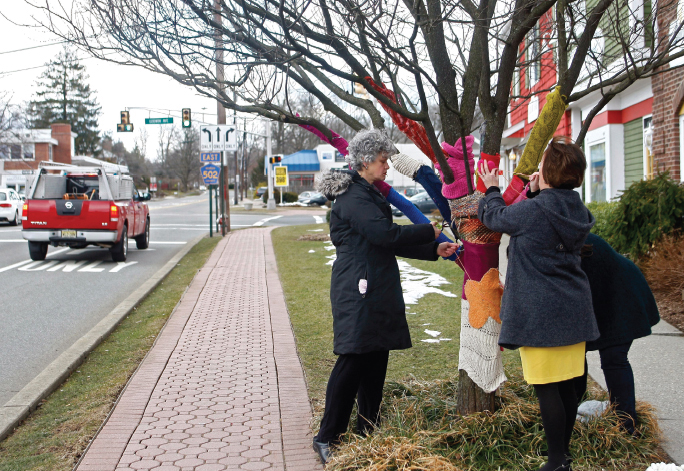Amy Kuperinsky, “Yarn Bombing”

NEWSPAPER
Amy Kuperinsky attended Columbia University’s Graduate School of Journalism and is a features writer for the New Jersey Star-Ledger, where this article originally appeared in 2013. She has worked as a reporter both in print and on the Web for over ten years. Important words and phrases have been italicized in this reading. Look up those you do not know, and write the definitions in your personal vocabulary list.


Yarn Bombing: The Worldwide Web of Knit Graffiti, from N.J. to Dubai
AMY KUPERINSKY
Yarn Bombing: The Worldwide Web of Knit Graffiti, from N.J. to Dubai
There may be nothing so analog as working with yarn—stitching and looping fibers by hand to create an interlocked network of fiber.
And in a digitally networked world, there may be nothing so pointless as a pay phone.
Lorna Watt, a crochet artist in San Mateo, California, would routinely notice them on local streets. To most they had become obsolete, irrelevant.
“People walk right by and they don’t even notice—because they’re on their phones,” says Watt, 35. That observation bred a question: “How much of our real world has become invisible because the virtual world has become so visible?”
5
In February, her question inspired a “yarn bomb,” the likeness of an iPhone—apps and all. The subject of her artistic assault? A pay phone—relieved of its receiver, its foundation knocked off-kilter, a graffiti tag marking a directory chained to the bottom. After hours of hooking and knitting, she produced a soft rectangle shell, black with 20 multicolored tiles. She slipped it over the phone.
And for a few weeks, passers-by looked up from their screens.
That’s the power of a yarn bomb—an “explosion” not of tinder and flame, but of texture and color.
In New Jersey and crafty hands around the globe, yarn bombing has become a mode of both expression and beautification. The point is to adorn street objects, many that wouldn’t be noticed otherwise.
While some assembly may be completed in plain view, yarn bombs are often conceived and executed, like graffiti, under the dark of night. In place of a paint can, the mechanism is yarn, knitted or crocheted. Yarn that’s hooked and needled around anything, natural or man-made—bridges, statues, pillars and bark.
10
In late March, on a grassy bank at the intersection of Franklin and Godwin avenues in Wyckoff, three women planted themselves firmly to the earth. As cutting wind swept the ground, their hands were steady, their mission clear. They would yarn-bomb a tree. A trio well-tested in the realm of seams and skeins, they’d walked just a few feet from their place of work—Close Knit, a nearby yarn store.

The shop’s owner, Kim Weiss, held a patch of fuchsia knit fast to one limb, gripping a needle with her teeth. An employee, Phyllis Rowley, threaded a pink strand through what looked like an electric blue leg warmer. Co-owner Carissa Mulloy stretched a narrow piece of fabric around a lanky branch, as if it were some tiny, naked elbow that needed shelter.
In a single afternoon, the women transformed a standard stretch of vegetation into a pastiche of fabric flowers, pea-green cable knit and sherbet-orange petals of what used to be a washcloth.
“That was a scarf,” said Rowley, pointing at a spot of knit stitched to the bark. “Now, it’s art.”
A stone’s throw from the tree, their showroom is stuffed with viscose braids and cubbies of thick, woolen spaghetti.
15
Still, yarn bombing isn’t just for yarn stores. In 2010, an entity dubbed “the Midnight Knitter” hit West Cape May. Residents awoke to find knit cozies hugging tree branches and sign poles.
“We never did identify exactly who was responsible,” says Mayor Pam Kaithern. “Periodically, you’d see different things popping up. It started, as I recall, with a stop sign and quickly moved into the adjacent park.”
The yarn bomber hit in late winter when not much was flowering.
“When all these vibrant colors started showing up, it just added a spirit of lightness,” says Kaithern, until someone cut the yarn down.
“It didn’t hurt anyone or anything,” she says. “The tree, I think, was one of my favorites.” Before its demise, Kaithern had visions of the yarn bomb in spring—birds tugging strands loose from covered limbs, like some scene out of “Cinderella.”
An Alternate View
20
On a June night in Frenchtown last year, a group of yarn-savvy residents worked by flashlight, their own mayor in tow. They pulled knitted and crocheted pieces over utility poles, benches and ironwork.
Yarn bombing is just the kind of thing you can do in a “tight-knit community,” says Frenchtown local Catherine Lent, 43—without laughing.
She organized the outing to mark June 9, the second annual International Yarn Bombing Day, founded in 2011 on the second Saturday in June by a Canadian yarn bomber (this year, it’s June 8).
Because of its sometimes covert approach, the practice has also been called knit graffiti—or even guerilla knitting.
But Leanne Prain prefers yarn bombing.
25
“You can’t forget about the crochet street artists,” says Prain, author of Yarn Bombing: The Art of Crochet and Knit Graffiti (Arsenal Pulp Press, 2009). “I’m partial to railings and poles. Why do they have to be boring? Make them striped, glittery and fuzzy with yarn.”
To reach an audience, yarn bombers don’t need everyone to visit their work the morning after—a photo and Internet connection will suffice. Prain, based in Vancouver, attributes the popularity of yarn bombing to the advent of craft blogs, with early bombs originating in Sweden, Scotland, and England.
For Sarah Knepper Rudder, an impetus for yarn bombing underlies much of street art. “You see a shape you like and you think, ‘That looks like something else to me,’” she says.
Last summer, when Knepper Rudder, 26, was living in Bellingham, Washington, a bollard, or stubby pillar, caught her eye. It was roughly the stature of R2-D2, that beloved, beeping Star Wars droid.
She went home and devised a pattern. Soon, her “yarn-two-dee-two” was a reality. She sat in a cafe across the street as passers-by stopped to take their picture with her creation. Knepper Rudder has since moved to California, taking the little knit droid with her—but says 126 users of Ravelry, an online fiber art community, have the pattern on their “to knit” list.
30
Upending the old “kitschy” feeling of handmade objects, yarn bombs are meant to generate an “unexpected sensation in the viewer,” says Lela Nargi.
The Cobble Hill, Brooklyn-based author of Astounding Knits (Voyageur Press, 2011), has seen them wedged in sidewalk cracks. “I love the idea of looking down and seeing a rainbow in what otherwise would be dirt-filled spaces,” says Nargi. And while anyone handy with a hook or needle might attempt a bomb, knit and crochet are viable as professional artistic mediums, too, Nargi says. “The truth is that there are some very serious artists who are working in fiber these days.”
A Charging Bull
Agata Oleksiak—known to the art world as Olek—has been “bombing” public spaces for years. Late Christmas Eve in 2010, Oleksiak draped large crocheted patches over Wall Street’s Charging Bull statue. She pieced her signature pattern—a staggered camouflage of hot carnation pink, shamrock green, slate gray and violet—over the beast. Yarn encased the entire bull, from horns and flared nostrils to meaty hind and curled tail. Though her crochet work was removed, a video of its assembly circulated online.
“With the bull piece, I created a movement that exploded internationally,” says Oleksiak, 35.
Also known as “Crocheted Olek,” Oleksiak, who lives in New York and came to the United States from Katowice, Poland, in 2003, has since covered many public objects in crochet, including a sleepy bronze Albert Einstein memorial at the National Academy of Sciences in Washington, D.C. “The End Is Far,” her recent solo exhibition at Jonathan LeVine Gallery in Manhattan, had crochet lining walls, a swing, live “mermaids” and “message” panels with as many lingering flourishes as the I Love Lucy credits.
35
Though fiber artists may use smart phones to preserve images of yarn bombs, Oleksiak sees knit expression as a reaction to digital overload.
“People, in a way, got tired of things made by computers and machines,” she says. But they stay connected—by however thin a thread—to the handmade realm. “Everybody can find themselves in it,” says Oleksiak. “You have a sweater or a blanket or scarves. You understand this language.”
LeVine, who lives in Rutherford, owns the gallery that hosted the artist Olek’s exhibition, which concluded in March. He likens her work to that of Christo (who created “The Gates,” the art installation that draped orange fabric throughout Central Park).
“People are just covering things,” says LeVine, of yarn bombing. “There’s not a lot of meaning to it.”
Global Mission
In the United States, the stringy stirrings of yarn bombing are attributed to Magda Sayeg. A decade ago, Sayeg embarked on “alpha,” her first yarn bomb. The goal: warmth. She bombed one of the tiniest knittable objects around, the door handle to her Houston shop.
40
“It was only a selfish pursuit to add color and a human quality to the cold steel facade,” she says. “It worked, but I had no idea of the greater impact it would have on me and the rest of the world.”
Sayeg, 39, is now based in Austin, Texas, and known as “Knitta,” short for “Knitta Please.” She is regularly commissioned for knit “interventions.” Sayeg once knitted a park scene for Gap’s holiday catalog and, with the help of a team, created a large-scale project for the New York City Department of Transportation. They wrapped a span of railing under the Williamsburg Bridge with yarn, spelling out the words “Plan Ahead.”
Sayeg recently traveled to Dubai in the United Arab Emirates, where she supervised like-minded work at an art fair. Her other international projects have involved cloaking a bus—headlights, hubcaps and all—in Mexico City, covering a long staircase in Sydney and fixing a leg warmer to a statue outside the Eiffel Tower.
“The bus in Mexico City will always have a special place in my heart,” she says. A smorgasbord of patterns occupied every crevice of the vehicle. Navy, white and turquoise yarn zigzagged the carriage as royal purple and lavender streamed downward, where mustard rosettes bloomed from tire bolts. It was 2008 and Sayeg’s sponsor was Absolut Vodka. She worked with a crew of fiber artists, refashioning existing blankets.
Yet Sayeg still keeps in touch with her knit graffiti roots. One night in March, without permission or commission, she posted a yarn skull to the corner of a blank Austin billboard.
45
As the bomb hit daylight, fans of Sayeg sent her photos. Corporately funded projects allow much time for planning and execution, says Sayeg, but solo night missions are of an entirely different fiber.
“The renegade type of approach is exciting,” she says. The message is much the same as notes scrawled on mucky windshields: “Notice me.”
It wasn’t long before the billboard’s owner did take notice. Within a few days, her skull was dismantled, that white void covered with a new sign.
The message: “For lease.”
QUESTIONS
Question
1. How does yarn bombing compare to traditional graffiti? Consider both the artwork itself and the creators of the art. Write a list of all the similarities and differences you can come up with in the box below.
Question
2. The majority of the yarn bombers referenced in the article are female, and, although there are some very well-known female street and graffiti artists, the majority of traditional graffiti artists tend to be male. Write a short paragraph discussing the possible gender differences between these two types of art.